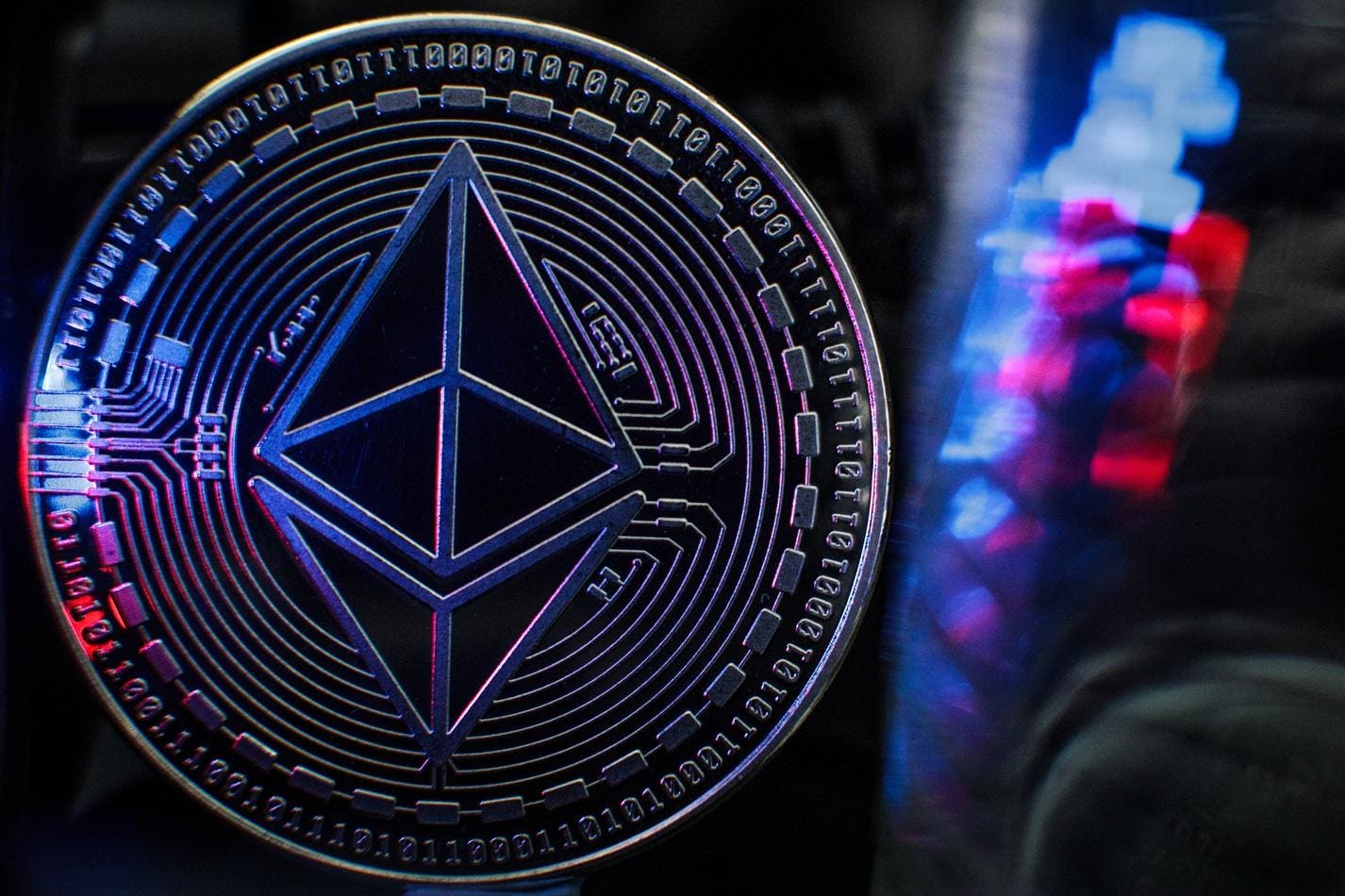Ethereum is a decentralized platform enabling the creation of decentralized applications using blockchain technology. This article explores Ethereum’s
Ethereum
What Is Ethereum?
Ethereum is a blockchain-based network that allows developers to build and deploy dApps and smart contracts without third-party interference. It extends the blockchain’s capabilities beyond digital currency, enabling programmable agreements and applications across various industries.
Unlike Bitcoin
Bitcoin
Founders and History
Ethereum was first proposed in 2013 by Vitalik Buterin, aiming to expand blockchain’s potential beyond financial transactions. Alongside co-founders Gavin Wood, Charles Hoskinson, Anthony Di Iorio and Joseph Lubin, Ethereum launched in 2015 after a successful crowdfunding ICO campaign. An ICO is an initial coin offering, something that is rarely seen today due to regulatory concerns. However, Ethereum pioneered the methodology leading to a spree of ICOs throughout the 2016-2017 bull run. The platform also introduced the Ethereum Virtual Machine and a programming language for smart contracts, marking a significant advancement in blockchain technology.
Ethereum’s inception brought about a new era of decentralized computing, enabling developers worldwide to create applications that operate without centralized control. Further, its open-source nature fostered a robust community, contributing to its rapid growth and adoption.
Today, there are several EVM-compatible chains, including BNB
BNB
Polygon
Avalanche
How Does Ethereum Work?
Ethereum is as a decentralized blockchain network which enables its smart contracts and dApps to run without downtime or censorship at the protocol level. It utilizes a distributed ledger to record transactions and state changes in smart contracts.
Developers write smart contracts using languages like Solidity, which are compiled to run on the EVM. Transactions and computations are validated by network participants (nodes) and secured through consensus mechanisms. Ether serves as the medium for compensating validators and facilitating network operations.
Blockchain Technology
Blockchain is a distributed ledger that records transactions across a network of computers securely and transparently. Each block contains a list of transactions, linked cryptographically to the previous block, forming an immutable chain.
Ethereum leverages blockchain to store and execute smart contracts, extending the technology’s utility beyond simple value transfer. This enables applications in DeFi, e-commerce, supply chain management, voting systems, prediction markets, and more, ensuring that smart contracts and dApps are tamper-proof and operate as programmed.
Smart Contracts
Smart contracts are self-executing agreements with terms directly written into code. They automatically execute when predefined conditions are met, eliminating the need for intermediaries and reducing costs. Even when all permissioned users such as admins are removed the code can continue to run indefinitely with no entity able to shut them down.
On Ethereum, smart contracts are fundamental, facilitating activities like token issuance, lending and decentralized exchanges. They enable programmable, trustless agreements, revolutionizing industries by introducing new business models and streamlining processes.
Decentralized Applications (dApps)
Decentralized applications run on a network of computers rather than a single server, leveraging blockchain for transparency and security. dApps operate according to their smart contracts, functioning without centralized oversight.
For example, even a dApp that is banned by a government can’t be shut down or have its access denied without admin rights to the code. While internet service providers may work with authorities to make it harder to access the dApp there is no way for it to be fully censored.
Ethereum has historically been the primary platform for dApp development due to its support for smart contracts and developer tools. However, other Layer 1 blockhains such as Solana, and Ethereum Layer 2 chains like Polygon, Avalanche and Base have increased in popularity due to lower fees and faster transaction times.
dApps are disrupting traditional industries by providing decentralized alternatives in finance, gaming, social media and supply chain management, enhancing user control and fostering innovation.
Ethereum Vs. Bitcoin
While both Ethereum and Bitcoin utilize blockchain technology, they serve different purposes and offer distinct features. The following sections highlight key differences and use cases to understand how these digital assets differ.
Key Differences
Bitcoin was designed as a digital currency and store of value, focusing on secure peer-to-peer transactions. Ethereum, however, is a programmable platform that is Turing complete, extending its capabilities beyond transactions.
Ethereum’s block time is shorter, allowing faster transaction confirmations. It also now employs a different consensus mechanism and has a flexible monetary policy compared to Bitcoin’s fixed supply.
However, Ethereum originally launched with a similar Proof-of-work consensus mechanism as Bitcoin, allowing network participants to mine ether using graphics cards. The protocol has since migrated to a more energy efficient proof-of-stake system.
Use Cases
Bitcoin is commonly used for censorship resistant peer-to-peer transactions and as a hedge against inflation. Its primary use cases involve payments, remittances and investment.
Ethereum supports a vast ecosystem of applications, including DeFi platforms, NFT marketplaces and decentralized autonomous organizations. Its versatility allows developers to create innovative solutions across various industries. Many view Ethereum as digital oil compared to Bitcoin’s digital gold narrative.
Additionally, Ethereum allows for tokenization of data meaning that both digital and real world assets can be represented by on-chain tokens for value transfer. Essentially, Bitcoin is a simple but elegant globally distributed monetary system while Ethereum is a decentralized computer with the ability to digitize value in many forms.
Ethereum’s Ecosystem
Ethereum’s ecosystem encompasses components that facilitate its functionality and growth. Key elements like the Ethereum Virtual Machine and other recent upgrades contribute to its adaptability and scalability.
Ethereum Virtual Machine
The Ethereum Virtual Machine is a runtime environment for smart contracts on Ethereum. It acts as the decentralized computer executing scripts across the network. The EVM enables developers to run code of arbitrary complexity, ensuring consistent behavior across the network.
By providing a secure environment, the EVM ensures smart contracts do not interfere with each other. It supports multiple programming languages and is integral to Ethereum’s ability to support complex decentralized systems.
Ethereum 2.0 (Eth2) Upgrade
Ethereum 2.0 was an upgrade aimed at improving scalability, security and sustainability. It introduced a shift from proof-of-work to proof-of-stake consensus and shard chains to increase transaction throughput.
The upgrade enhanced the network’s capacity, reducing congestion and fees. Transitioning to proof-of-stake lowered energy consumption and promoted a decentralized validator ecosystem. Eth2 included a series of upgrades transforming the network’s infrastructure.
The upgrade, along with an additional change causing a percentage of gas to be burnt with each transaction led to Ethereum becoming deflationary. Since The Merge the total supply of ether has decreased by 160,923 ETH, around $418 million. This reduction created an inflation rate of -0.066%.
Decrease in ether supply since The Merge
Had Ethereum kept its proof-of-work mechanism the supply would have grown by 7,903,486 ETH, equivalent to around $20.5 billion and an inflation rate of 3.2%.
Ethereum’s Consensus Mechanism
Consensus mechanisms are crucial for blockchain security and operation. Ethereum’s transition from proof-of-work to proof-of-stake marked a significant evolution in how the network reached agreement on transactions.
Proof-of-Work (PoW) Vs. Proof-of-Stake (PoS)
Proof-of-work requires miners to solve complex puzzles to add new blocks, consuming substantial energy. Bitcoin and the original Ethereum network used PoW.
Proof-of-stake replaces miners with validators who stake ether to participate in block validation. Validators are chosen based on the amount they stake, reducing energy consumption and aligning economic incentives with network security.
Transition To Proof-of-stake
Ethereum transitioned to proof-of-stake in September 2022 through a process known as The Merge, combining the original Mainnet with the Beacon Chain. This eliminated energy-intensive mining, reducing energy consumption by approximately 99%.
The transition improved network security and sustainability while maintaining Ethereum’s core functionalities. It set the stage for future scalability upgrades within its roadmap like sharding.
Ethereum Wallets
Ethereum wallets allow users to interact with the network, manage ether and tokens, and access dApps. Wallets include hardware wallets like Ledger, software wallets like MetaMask, web wallets and mobile wallets.
When choosing a wallet, consider security features, ease of use, dApp compatibility, NFTs, and support for multiple tokens. Hardware wallets offer enhanced security by storing private keys offline, while software wallets provide convenience but may be more vulnerable to cyber threats.
Users should also decide between custodial wallets, where a third party holds private keys, or non-custodial wallets, providing full control over funds. Balancing security with accessibility is key.
Ethereum’s Risks And Challenges
Ethereum faces challenges such as scalability issues, where high network usage leads to congestion and increased fees. While upgrades aim to address this, full implementation is ongoing.
Security vulnerabilities in smart contracts pose risks, as flawed code can be exploited, leading to financial losses. Regulatory uncertainties also may impact adoption and operation in various jurisdictions.
Competition from other blockchain platforms offering similar capabilities presents a challenge, potentially drawing users and developers away from Ethereum. Most recently, Layer 2 blockchains like Base have started to gain considerable traction. As a result, the number of daily transactions on Ethereum mainnet have stagnated. This has led to Ethereum’s supply to increase as less gas is burnt, causing it to become slightly inflationary once again.
Ethereum’s Future
Ethereum’s future involves upgrades to improve scalability and usability. Post-merge developments focus on implementing shard chains, increasing transaction throughput and efficiency.
Layer 2 scaling solutions like Optimistic Rollups reduce congestion by processing transactions off-chain. These enhancements aim to support a growing ecosystem of dApps.
Continued innovation in DeFi, NFTs, AI and new applications will likely expand Ethereum’s influence. Its adaptability and active community position it as a leading force in blockchain technology.
Further, Ethereum’s development roadmap extends beyond The Merge, outlining five key phases aimed at enhancing the network’s capabilities.
As Ethereum co-founder Vitalik Buterin has described, these stages include The Surge, focusing on scalability improvements through sharding and layer 2 solutions; The Scourge, addressing decentralization concerns and economic centralization risks; The Verge, aimed at simplifying block verification and improving data storage efficiency; The Purge, designed to reduce computational costs for node operators; and The Splurge, encompassing various smaller upgrades to “fix everything else.”
Buterin’s Ethereum roadmap
These phases are part of a long-term vision to create a more scalable, secure and sustainable blockchain ecosystem. While the exact implementation timeline remains fluid, each stage represents a critical step in Ethereum’s evolution, potentially reshaping the network’s performance and utility in the broader cryptocurrency landscape.
Bottom Line
Ethereum is a versatile platform extending beyond digital currency to enable smart contracts and decentralized applications. Its evolution to Proof-of-stake is seen by many as progress toward scalability, security and sustainability.
Ethereum continues to develop through upgrades and innovations and it remains foundational in driving advancements in DeFi, digital assets and blockchain applications. However, the increase of EVM-compatible Layer 2 blockchains have reduced mainnet activity. Further, competition from chains like Solana
Solana



